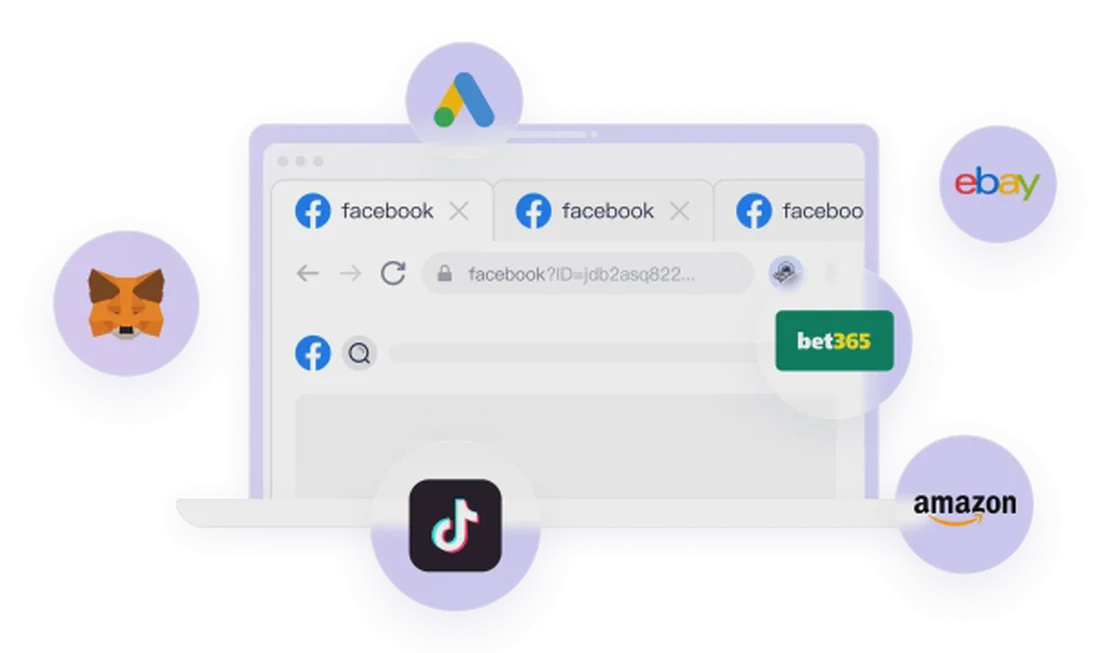“Dear Creator, your YouTube channel has been suspended due to repeated violations of our Community Guidelines.”
When this cold email lands in your inbox, what is your first reaction? Is it a sense of disbelief, or an instant feeling of despair sinking to your stomach? For a creator who has poured countless nights and immense effort into content creation, this can feel like a devastating blow. Carefully planned video scripts, hours of hard-fought footage, and every genuine interaction with your fans—seems to vanish in an instant.
If you’re facing this situation, take a deep breath before panicking. An account suspension, while deeply frustrating, is not the end of the world. It’s more like a severe warning signal, telling you that YouTube’s “iron-fisted judge”—its automated or human review teams—has identified your actions as crossing a “red line” in the community. The key question is whether you can, like a skilled attorney, clearly prove your “innocence” or demonstrate a sincere commitment to change.
This guide will take you inside YouTube’s “court of law,” systematically analyzing the deep-seated reasons for channel suspensions and providing you with a precise and effective “appeal strategy.” We will also reveal how to establish a sustainable and secure content creation system, giving your channel a new lease on life and preventing a tragedy from recurring.
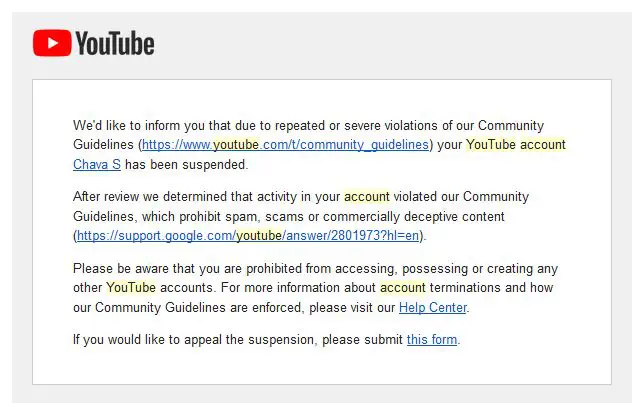
Why Does YouTube “Flash the Red Light”? 5 Common Reasons for Account Suspensions
Before you “plead your case” to YouTube, you must first understand which guideline you have violated. YouTube’s Community Guidelines system is vast, but the vast majority of severe account suspensions (“Account Suspended”) fall into a few core areas. Understanding them is the first step to an effective appeal and an essential lesson for avoiding future mistakes.
Reason 1: Serious Copyright Infringement
This is one of the most common and severe reasons for suspension. YouTube is extremely strict about copyright law because, as a massive content-sharing platform, it must protect the rights of original creators. Any action that a copyright holder deems infringing can have fatal consequences for your channel.
Common Infringement Acts:
- Unauthorized Audio Usage: Using music or sound effects in your videos that you downloaded from the YouTube Audio Library or other sources with explicit copyright notices (e.g., “Copyright - All Rights Reserved”).
- Unlicensed Video Footage: Clips or direct use of video fragments from movies, TV shows, or other creators.
- Game/Software Content: When streaming or recording gameplay or software demos if you are not using content explicitly authorized by the copyright holder.
- Images and Background Music: Even a single copyrighted image or piece of music used in a video thumbnail or background can become the subject of a claim.
Suspension Logic: Copyright holders (typically major record labels, film studios, etc.) have access to the Content ID system. Once your video is matched against their copyright database, they can directly issue a “copyright claim” against your channel. However, multiple claims, or receiving multiple copyright strikes from different holders, dramatically increases the risk of your channel being terminated.
Reason 2: Spam, Deceptive Practices, and Scams
This guideline is designed to maintain a healthy community environment by combating deceptive, misleading, or harassing content. It covers a wide range of actions, but its core is “malicious intent.”
- Typical Spammy Content:
- Phishing and Scams: Creating videos intended to steal users’ personal or financial information, such as fake official notices or fraudulent “prize” links.
- Malware/Virus Distribution: Videos or their descriptions containing links to malicious software, viruses, or other harmful downloads.
- Spam Comments/Messages: Posting repetitive, meaningless comments (e.g., “view for view,” “check out my channel”) on a large number of unrelated videos, or including spam links to external websites.
- Misleading Thumbnails and Titles: Using controversial or irrelevant images (like shocking graphics) as thumbnails, or clickbait titles (e.g., “Click for a surprise”) to mislead viewers and gain illicit traffic.
Reason 3: Child Safety
This is an area where YouTube has invested tremendous resources in recent years, especially concerning child-directed content. The platform has a “zero-tolerance” policy for such violations.
- Key Red Lines:
- Harmful Behavior to Minors: Any form of bullying, harassment, exploitation, or violence against children in videos.
- Inappropriate Content for Children: Even if the video is not targeting children, if it contains violence, nudity, dangerous acts, etc., and is age-restricted by YouTube’s systems, and your channel is designated as “made for kids,” it can trigger severe penalties.
- Deceptive Content:For example, channels that create content that appears to be animations or children’s songs but actually contains violence, adult references and other “toy breaking” or parody content are easily banned.
Reason 4: Harassment, Bullying, and Hate Speech
YouTube is committed to fostering a safe and respectful environment for all creators and viewers. Any form of attack or targeted harassment based on personal attributes (race, religion, gender, sexual orientation, etc.) can lead to severe account penalties.
- Specific Manifestations:
- Targeted Attacks: Persistently harassing or threatening a specific individual.
- Hate Speech: Spreading hatred and discrimination against protected groups in videos, comments, or Community posts.
- Malicious Name-Shaming and Humiliation: Prominently featuring another person’s name or image in video titles or thumbnails without permission for negative purposes.
Reason 5: Misinformation and Harmful Deception
While the platform advocates for free speech, it is taking increasingly strict measures against spreading false information with high real-world potential for harm.
- Key Monitored Areas:
Election Fraud Baseless Allegations: Unsubstantiated claims intended to undermine the credibility of elections, regarding voting or vote-counting processes.
Dangerous Conspiracy Theories: Such as promoting organizations or conspiracy theories (e.g., QAnon) that the platform has designated as dangerous.
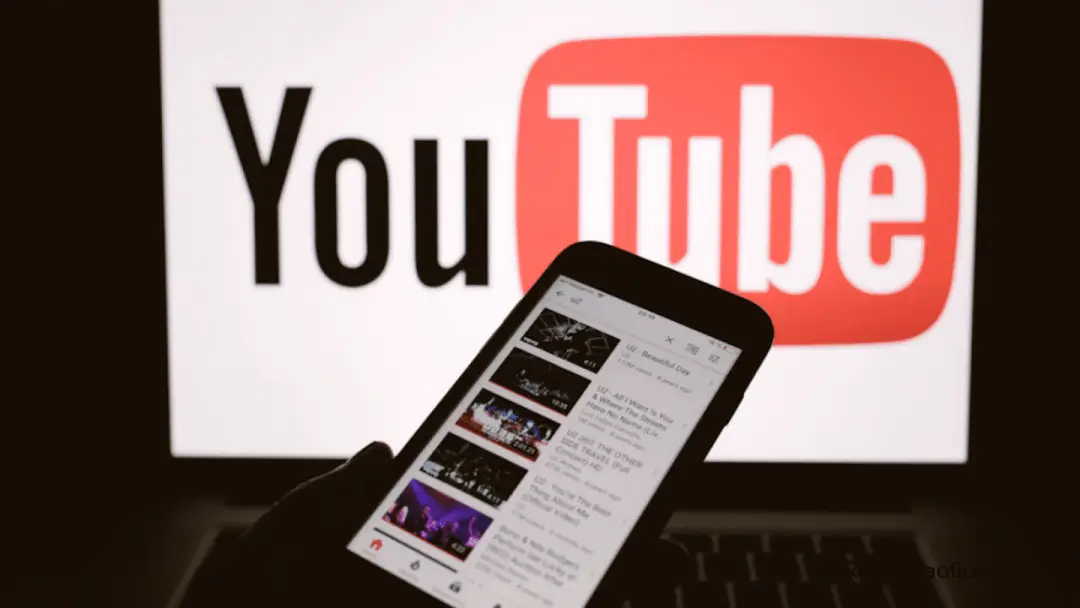
A Practical Guide to YouTube “Resurrection”: A 4-Step Appeal Strategy
When you receive the “Account Suspended” notice, anxiety is a natural reaction. However, appealing blindly will only waste precious time and could even worsen the situation. You need a calm, rational appeal strategy.
Step 1: Calm Self-Check, Identify the “Culprit”
Before appealing, take 15 minutes to sit down and calmly reflect. Review your recently uploaded videos, comments, and Community posts.
- Did you use the wrong piece of music?
- Was that gameplay clip unauthorized?
- Did you say something overly harsh in a comment?
- Is there “clickbait” in a video’s title or thumbnail?
- Is your entire account suspended, or just individual videos removed? If only videos are removed, your account is still at risk but the situation is less severe.
Pinpointing the exact problem will allow you to make a targeted appeal letter. If you truly can’t figure it out, don’t guess randomly. You can honestly state that you’re unsure of the specific reason but promise to strictly adhere to the Community Guidelines.
Step 2: Draft a “Sincere, Specific, and Persuasive” Appeal Letter
This is the absolute core of the entire appeal process. Your goal is to convince YouTube’s reviewer that you understand your mistake and will not repeat it.
How to Find the Appeal Portal?
In your inbox, find the “Your account has been suspended” email from YouTube.
Click the “Appeal this decision” button in the email. This will typically take you to YouTube’s appeal page.
If the link is broken, you can try visiting Google’s appeal form page directly: https://support.google.com/youtube/answer/2802168
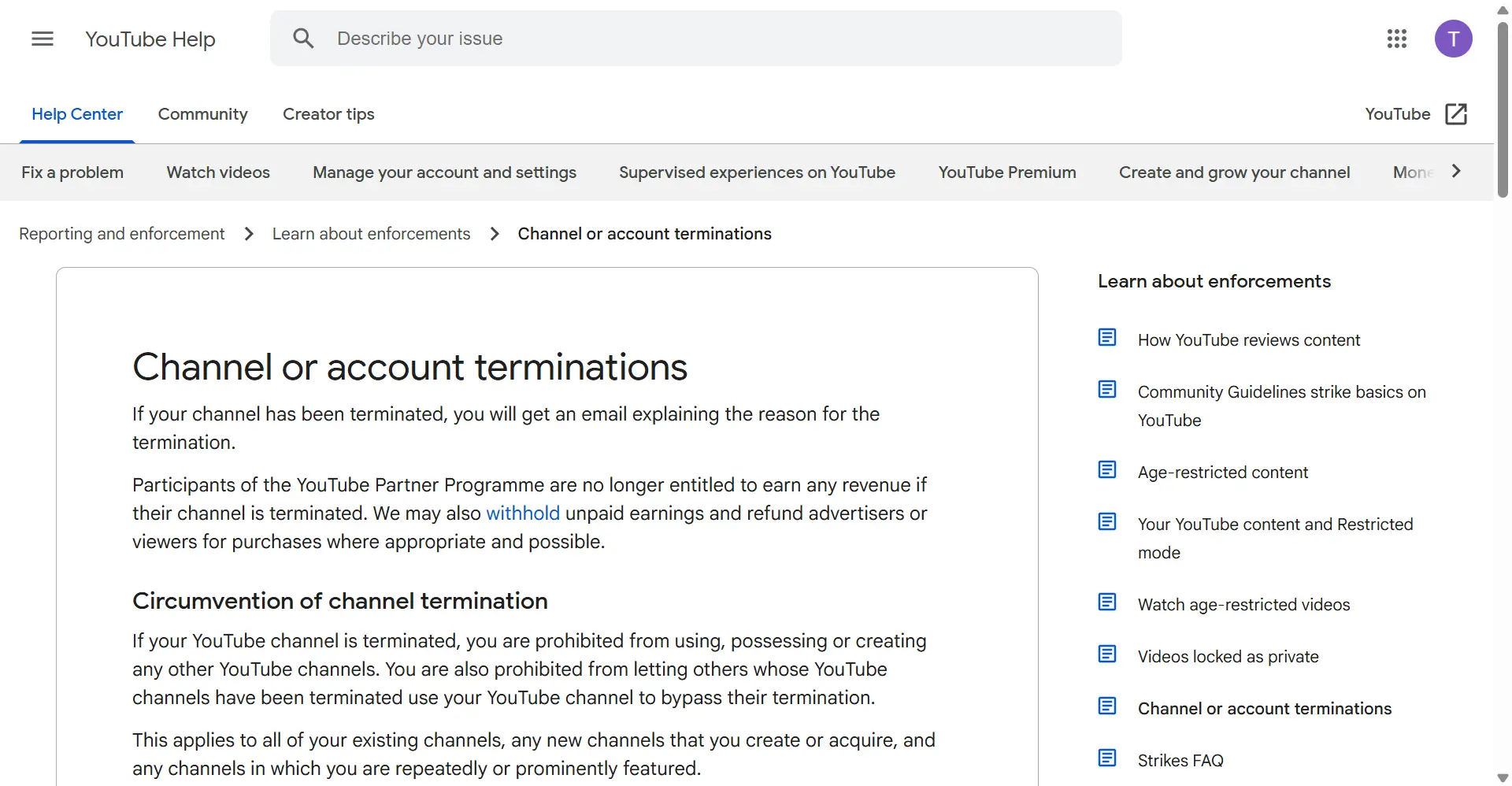
The “Golden Structure” Template for Your Appeal Letter:
Subject: Appeal for Channel Suspension - [Your Channel Name]
Body:
Dear YouTube Review Team,
Hello! I have received your notification informing me that my YouTube account (Channel Name: [Your Channel Name], Email: [Your registered email]) has been suspended for violating Community Guidelines. I am very shocked by this decision and place high value on my channel and audience.
[State Attitude, Admit Fault] I have carefully read the notification and have reviewed all videos and comments I’ve recently posted on my channel. I realize I did indeed violate YouTube’s rules in [Choose the problem you identified in your self-check, or write more generally “the choice and expression of video content”]. For this, I am deeply sorry. I understand the importance of maintaining a healthy, responsible creative environment, and I am remorseful for my negligence.
[Analyze Root Cause, Show Sincerity] I previously had a superficial understanding of certain community guidelines, such as [Be specific, e.g., “the rules for using some copyrighted music” or “the requirement that titles and thumbnails must be highly relevant to the content”]. After this lesson, I have thoroughly re-read and understood YouTube’s Community Guidelines and Copyright Policy, and I now fully realize the error of my ways. I promise that I will conduct a strict compliance review before publishing any content in the future.
[Commit to Future Actions, Ask for a Second Chance] This channel is a project I have invested a great deal of heart and effort into. It is not just a platform for showcasing my work, but a precious community where I’ve built connections with many supporters. I sincerely ask the review team to give me a chance for redemption and lift the suspension on my account. I promise to fully comply with all platform rules in the future, creating more positive and valuable original content, and contributing to the healthy growth of the YouTube ecosystem.
Thank you for reviewing my appeal. I look forward to your response.
Best regards,
[Your Name or Channel Name]
[Date]

Step 3: Be Patient and Follow Up
After submitting your appeal, your main job is to wait. YouTube’s review team handles a massive number of appeals daily, so this could take days, or even one to two weeks. During this time, please:
- Do Not Resubmit Your Appeal: Frequently submitting the same appeal or rushing them will likely be ignored by the system and may even be flagged as spam.
- Keep Your Contact Information Active: Ensure your email is working correctly and can receive messages.
Step 4: The Last Resort After an Appeal is Denied
If the response you receive is still “appeal denied” and the notice states “this decision is final,” it means your appeal was unsuccessful. In this situation, your options are very limited:
- Accept it and Start Over: This is the most realistic option. You need to learn from your mistakes and create a brand new channel using a new, clean email address (ideally a brand new Google account). This time, be sure to learn and strictly follow all rules from day one.
- Seek Help: If you believe this was a mistake caused by a system error, you can try posting a clear explanation of your situation in the official YouTube Community tab or Help Forum to see if you can catch the attention of official support staff, but the success rate for this is generally low.
After Reinstatement, How to Build an Impenetrable “Channel Security Fortress”?
Account reinstatement doesn’t mean you can “rest easy.” This is just the beginning of your “recovery.” The real challenge lies in building a sustainable, secure operational system to ensure your channel can thrive for the long haul.
Respect the Rules and Never Stop Learning: Treat YouTube’s “Community Guidelines” and “Copyright Policy” as your “bible,” read it through at least once, and bookmark it. Platform rules are dynamic; make it a habit to check for updates regularly.
Build a Library of Original Content: Whether for video editing, music, or background footage, prioritize original work or officially licensed material (like the YouTube Audio Library, Video Library, or royalty-free stock sites) to eliminate copyright risks from the source.
Meticulously Review Every Step: Before uploading a video, develop a “self-checklist”: Is the title objective? Is the thumbnail respectful and relevant to the content? Is the interaction in the comments section positive and healthy?
Protect Your “Digital Assets”: As an up-and-coming creator, securing your one and only, legitimate account is crucial. For creators who need to manage multiple accounts (e.g., testing different content types, running a side-channel), be absolutely sure that every single account is operated in a completely isolated environment to avoid “one city gate catching fire, harming the fish in the moat.”
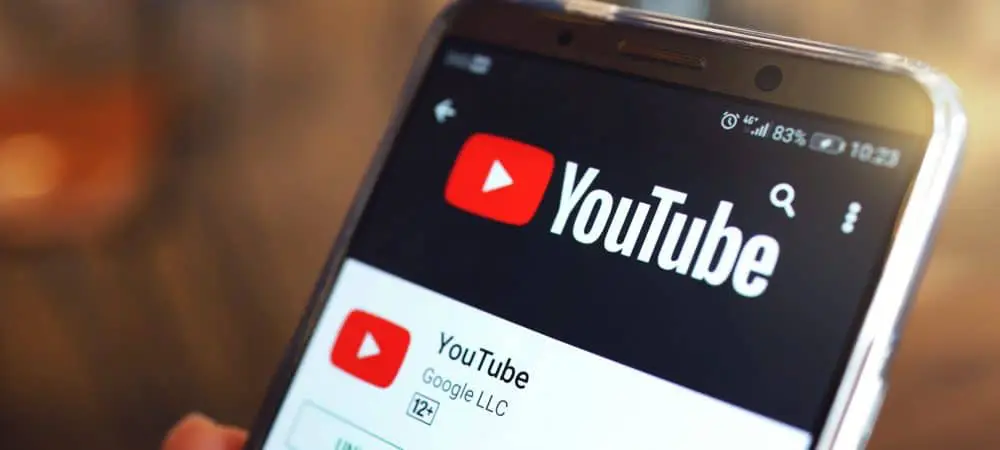
The Pro Creator’s “Invisible Shield”: FlashID Multi-Account Management Solution
For ambitious creators, especially professionals who need to manage a main account, test accounts, brand accounts, or for team collaboration, “environmental isolation” is the first and most critical line of defense for account security. It’s impractical to equip every account with its own separate computer.
This is when a professional multi-account management solution shifts from an “advanced tool” to a “must-have.” This is precisely where FlashID plays a pivotal role.
- Create a Unique “Digital Identity” for Each Account: FlashID’s fingerprint isolation technology allows you to create a completely separate and isolated browser environment for each YouTube account (or any Google account) on a single physical computer. This environment has a unique digital fingerprint (browser, language, timezone, resolution, etc.) and an exclusive proxy IP address. This means that when you operate on Account A, no data will “leak” into Account B’s environment. To YouTube’s risk control system, these accounts appear as independent creators from different corners of the world using different devices, fundamentally eliminating the risk of “environmental association” and allowing you to safely operate a multi-account matrix.
- A Secure Base for Mobile Content Creation: Many creators are accustomed to managing their channels, replying to comments, or using the YouTube Studio app on their phones. FlashID’s cloud phone feature provides the perfect solution for secure mobile operations. Each cloud phone is a standalone, clean Android operating system where you can log in one YouTube account. This is equivalent to giving each of your accounts its own dedicated “content creation phone,” achieving complete physical and environmental isolation for mobile accounts. It’s a “cornerstone of security” for activating new accounts and maintaining old ones.
- Automated Management, Focused on Creation: FlashID’s powerful RPA (Robotic Process Automation) and window synchronization features can help you automate repetitive tasks like uploading videos, replying to comments, and analyzing data, saving you precious creative time so you can focus on the content itself rather than being bogged down by tedious account management tasks.
For any YouTube creator who doesn’t want a single technical mistake to destroy all their hard work, FlashID is the intelligent choice for ensuring account security and achieving efficient, compliant operations.
Frequently Asked Questions (FAQ) on YouTube Account Appeals and Protection
Q: My YouTube account was suspended for “spam comments,” but I was just trying to get more people to see my channel by visiting other videos and leaving comments. Why is this a violation?
A: I understand your intention, but YouTube’s definition of “spam comment” is very broad. Any valueless comment left on unrelated videos with the intent to direct traffic to your channel is considered spam. This behavior disrupts the community experience, and even if you didn’t have malicious intent, the platform will still penalize it. The right way to attract traffic is by creating high-quality content that makes viewers come to your channel organically.
Q: I used a song from the YouTube Audio Library, but I still got a copyright claim. Why?
A: This could be for two reasons. One, you might have downloaded music that is only available for “Premium” members, and your account is not one. Two, you might not be using the official YouTube Audio Library, but free music from another site, which may have copyright issues. Please be sure to select music from
YouTube Studio > Create > Audio Librarythat is explicitly marked as “free to use.”Q: My appeal was rejected, and it says “this is the final decision.” Is there really nothing I can do?
A: Yes, when YouTube states “this is the final decision,” it means their internal review process is complete, and the chances of a successful appeal are extremely slim. At this point, the most realistic and effective step is to learn from your mistake, create a brand new, clean account (with a clean IP, a clean device), and strictly follow all the rules from scratch.
Q: If I want to make gaming commentary videos, what’s the safest way to handle copyright issues?
A: The safest ways are:
- Completely Original Content: Your commentary, editing, score, and voice-over must be original; the gameplay footage is merely your raw material.
- Obtain Explicit Permission: Proactively contact the game developer and get their written authorization, informing them that you will use it for commercial YouTube commentary.
- Use “Fair Use”: “Fair use” is a legal concept, not a YouTube rule. It allows limited use of copyrighted material without permission for specific purposes like criticism, comment, news reporting, and teaching. However, the line is blurry, and there is a risk of being sued, so I do not recommend this as a primary strategy for beginners.
Q: My channel was suspended. Are my videos, subscriber count, and earnings gone forever?
A: Unfortunately, in the case of a permanent account suspension, all data on your channel (videos, metadata, subscribers, comments, earnings, etc.) is usually unrecoverable. Therefore, during operation, be sure not to put all your eggs in one basket. Important content must be backed up on your local hard drive or a private server.
Q: Was my entire channel suspended, or were some videos just removed or age-restricted? What’s the difference?
A: These are two completely different situations.
- Video Removed/Age-Restricted: This is a penalty against a single video. Your account itself is still in good standing. It’s a warning sign telling you that something is wrong with that video and it needs to be changed or to follow the rules.
- Account Suspended: This is the penalty against the entire account, the most severe one. Your account will be unable to log in, unable to create new content, and all functions will be locked. It is usually caused by multiple severe violations or a single “egregious” violation.
Q: Can I use FlashID to manage my multiple YouTube channels? Can it guarantee my channel’s safety?
A: Absolutely. FlashID’s core function is to prevent suspensions due to environmental association. By creating isolated browser environments and IPs for each YouTube account, it allows you to safely manage multiple channels, especially when you need to do A/B testing, content testing, or build a multi-brand matrix. However, this doesn’t mean you can ignore YouTube’s content rules; complying with them is still the top priority.
Q: Can I use FlashID’s cloud phones to log in to multiple YouTube accounts? Is this safe to do?
A: It’s not only suitable but also very safe. By using FlashID’s cloud phones, you can assign a separate cloud phone to each YouTube account (especially Google account). This way, the login environment and operational records of each account are completely independent and will not affect each other, perfectly solving the risk of environmental association for multi-account operations on the mobile side.
Q: What’s the most effective way to send my appeal letter? Should I post it on the official forum or send it via email?
A: The most effective way is to appeal through the official appeal form provided by YouTube in the suspension email. This is the only official channel to send your appeal directly to the team specifically handling these cases. Posting on public forums or social media, while it might garner sympathy or discussion from other users, is unlikely to ensure that your case is seen and processed by YouTube’s official review team.
Q: Besides copyright and spam content, what other actions that beginners might overlook can result in being banned?
A: Two very important points:
- Malicious Name-Shaming and Humiliation: Do not prominently display another person’s real name or likeness in video titles or thumbnails without consent, especially with negative intent. This is a form of harassment and is easy to report and lead to suspension.
- Impersonating Official Brands or Governments: Do not create a channel with a name, logo, and interface that is highly similar to a well-known brand, government agency, or YouTube itself, in an attempt to mislead users. This is considered impersonation and will result in an immediate suspension.
